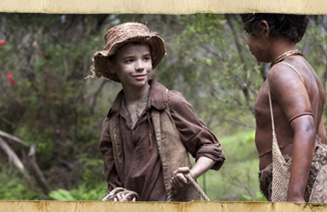Note:
this activity requires students to view the whole of Episode 22 | 1798 (not just the third clip Oranges and lemons). The DVDs of the series may be purchased from the Australian Children's Television Foundation (www.actf.com.au/catalog/item/200) or the ABC Shop.
Discover
-
As a class, view Episode 22 | 1798, and focus on how Sam is taught to be afraid of Indigenous people. Focus on Mr Owen's comment in the first clip Farm lad, that 'behind every stand of trees, there are eyes that have no love'. Ask students to list ways in which the filmmaker attempts to make Sam and the audience feel frightened of Indigenous people. Refer students to Student Activity Sheet E22.6 Feeling frightened.
- Explore other ways Indigenous peoples are represented in books, in pictures or illustrations, in the media, in films, etc. Look at a range of texts from past and present and compare these by asking some of the questions below:
- Do all groups express their point of view or is only one viewpoint given?
- Are readers made aware of the positive roles played by Indigenous people through history and today?
- Do photographs come with captions that include the name of the person or group saying where they are from?
- Are all people represented in the storyline, the text or the illustrations?
- Are people portrayed as being in control of their own lives and able to resolve challenges?
- Is the diversity of Indigenous cultures referred to?
- Are specific Aboriginal languages and cultures referred to, or is there an implicit assumption that there is one 'Aboriginal culture'?
- Please note: many texts prior to the 1980s may use stereotypical images and language to present an often negative view of Indigenous people or position them as problematic. Be sure to examine the texts carefully using the questions above to guide you.
- Find an article in the newspaper about Indigenous people and identify the positive and the negative language used to describe Indigenous groups or individuals. Ask the questions above and discuss how Indigenous people are represented in the media today.
- Focus students' attention on the fact that although Sam used to be frightened of the Aboriginal boy, that fear has been replaced by friendship and respect. Ask students to describe:
- What happened to Sam to cause him to change his attitude?
- What visual evidence there is that shows Sam and the Aboriginal boy are friends at the end of the episode?
- If this episode has been viewed by students, point out that in Episode 21 | 1808, the older Sam is still friends with an Aboriginal man. Note Sam's comment in that episode that there 'were no problems at all' with Indigenous people.
- How is tension built in the clip where Sam is looking for the lost goat in the bush? What technical and framing devices are used by the filmmaker to create Sam's anxiety and frustration about finding the goat?
Reflect
- Divide the class into pairs. In each pair, one person takes the role of Sam and one the role of the Indigenous boy. The pairs can role-play a conversation between Sam and his new friend in which they discuss their thoughts and feelings about each other, their lifestyles, their daily duties, their roles and responsibilities, their daily diet, and so on.
-
Explore the documentary Reel Injun, about the representation of American Indians (Native Americans) in film through the history of cinema in America:
-
Reel Injun: on the trail of the Hollywood Indian, www.reelinjunthemovie.com/site/
-
YouTube, 'Reel Injun Promo', www.youtube.com/watch?v=HqVmqK5Nbuk
- Consider how Australian Indigenous people have been represented in films over time and how that is changing today.
The following websites may be useful:
-
Australia.gov.au, 'About Australia: Indigenous film', http://australia.gov.au/about-australia/australian-story/indigenous-film
-
Australian Screen, 'Indigenous Australia' http://aso.gov.au/education/indigenous/
- In small groups, choose one of the films mentioned in the websites above, or choose another Australian film from your library or research online. Watch the film, a promo or a clip from the resource and reflect on how Indigenous people are represented in the film using the questions below as a guide:
- Do all groups get to express their point of view or is only one viewpoint given?
- Do members of the group have a range of emotions and behaviour or do they all act the same?
- Are Aboriginal people shown taking part in the society in a variety of ways, or are they presented only in particular or limiting roles, eg hunting, fishing?
- Are people represented with a range of skills, or are they restricted, eg Indigenous people are good at sport or art.
- Are viewers made aware of the positive roles played by Indigenous people through history and today or is there a focus on the negative?
- Do the images include the name of the person or group, including where they are from?
- Are all people represented in the storyline? Do we get to know them as people?
- Are the Aboriginal people portrayed as being in control of their own lives and able to resolve their own challenges?
- Is the diversity of Indigenous cultures referred to or acknowledged?
- Are specific Aboriginal languages and cultures referred to?
- Share your reflections with the class and discuss.
Download
Student Activity Sheet E22.6: Feeling frightened



![Farm lad [Episode 22 | 1798 : Sam] Farm lad [Episode 22 | 1798 : Sam]](/assets/interface/images/spec_graphic/clip/1798/1/thumb.jpg)
![Milking time [Episode 22 | 1798 : Sam] Milking time [Episode 22 | 1798 : Sam]](/assets/interface/images/spec_graphic/clip/1798/2/thumb.jpg)
![Oranges and lemons [Episode 22 | 1798 : Sam] Oranges and lemons [Episode 22 | 1798 : Sam]](/assets/interface/images/spec_graphic/clip/1798/3/thumb.jpg)

